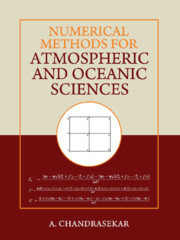Book contents
- Frontmatter
- Dedication
- Contents
- List of Figures
- Foreword
- Preface
- 1 Partial Differential Equations
- 2 Equations of Fluid Motion
- 3 Finite Difference Method
- 4 Consistency and Stability Analysis
- 5 Oscillation and Decay Equations
- 6 Linear Advection Equation
- 7 Numerical Solution of Elliptic Partial Differential Equations
- 8 Shallow Water Equations
- 9 Numerical Methods for Solving Shallow Water Equations
- 10 Numerical Methods for Solving Barotropic Equations
- 11 Numerical Methods for Solving Baroclinic Equations
- 12 Boundary Conditions
- 13 Lagrangian and Semi-Lagrangian Schemes
- 14 Spectral Methods
- 15 Finite Volume and Finite Element Methods
- 16 Ocean Models
- Appendix: Tridiagonal Matrix Algorithm
- Bibliography
- Index
Preface
Published online by Cambridge University Press: 22 February 2022
- Frontmatter
- Dedication
- Contents
- List of Figures
- Foreword
- Preface
- 1 Partial Differential Equations
- 2 Equations of Fluid Motion
- 3 Finite Difference Method
- 4 Consistency and Stability Analysis
- 5 Oscillation and Decay Equations
- 6 Linear Advection Equation
- 7 Numerical Solution of Elliptic Partial Differential Equations
- 8 Shallow Water Equations
- 9 Numerical Methods for Solving Shallow Water Equations
- 10 Numerical Methods for Solving Barotropic Equations
- 11 Numerical Methods for Solving Baroclinic Equations
- 12 Boundary Conditions
- 13 Lagrangian and Semi-Lagrangian Schemes
- 14 Spectral Methods
- 15 Finite Volume and Finite Element Methods
- 16 Ocean Models
- Appendix: Tridiagonal Matrix Algorithm
- Bibliography
- Index
Summary
The mathematical equations that govern the evolution of the atmosphere and the oceans are essentially a system of coupled nonlinear partial differential equations that do not provide for closed form analytical exact solutions. In situations where closed form analytical solutions are not available, one employs numerical methods for solving the governing mathematical equations that are responsible for the evolution of the atmospheric and oceanic systems. It is clear that advances in numerical methods have contributed greatly to our current understanding of the science of the Earth system in general and the sciences of the atmosphere and oceans, in particular. This book, Numerical Methods for Atmospheric and Oceanic Sciences, is written with an objective to provide a detailed and broad overview of the various numerical methods that are applied to fluid systems in general, and in particular to the fluid systems that manifest in the natural environment such as the atmosphere and hydrosphere. Most of the material included in this book has evolved from a single semester course that I taught on “NumericalWeather Prediction” as well as another course that I had taught earlier titled “Numerical Weather Prediction and Modeling.” The approach followed in writing this book is to provide adequate theoretical and background discussions that go beyond mere outlining and mentioning the various numerical schemes.
I have dedicated this book to the memory of Professor T. N. Krishnamurti, former Lawton Distinguished Professor, Department of Earth, Ocean and Atmospheric Science, Florida State University, USA, for his pioneering research contributions in the areas of numerical weather prediction, short and long range monsoon prediction, inter-seasonal and inter-annual variability of the tropical atmosphere. Professor Krishnamurti visited my institute twice, once in 2014 and again in 2015. I was truly amazed with Professor Krishnamurti's depth of knowledge, his prolific research output as well as the huge impact of his research on the science of the atmosphere. I am extremely indebted to Professor S. Lakshmivarahan, George Lynn Cross Research Professor Emeritus of the University of Oklahoma, USA, for readily agreeing to my request to write a Foreword for this book. I am certain that a Foreword from someone of his stature and eminence would contribute immensely to the popularity of the book.
- Type
- Chapter
- Information
- Numerical Methods for Atmospheric and Oceanic Sciences , pp. xxix - xxxPublisher: Cambridge University PressPrint publication year: 2022

